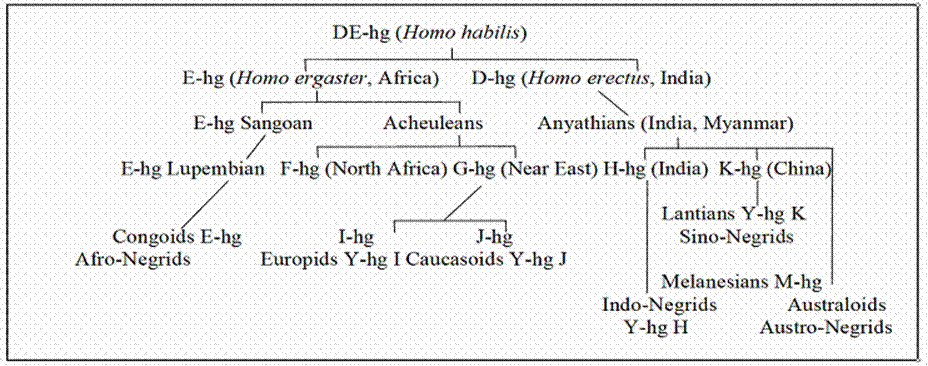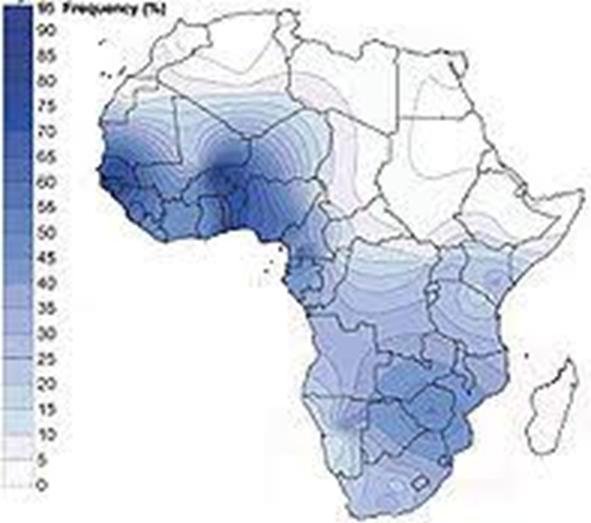|
|
Democritus Reformatorium Prehistoric tribes Prehistoric races Prehistoric languages |
|
||||||||||||||||||||||||||||||||||||||||||||||||||
|
|
|
|
||||||||||||||||||||||||||||||||||||||||||||||||||
|
|
|
|
||||||||||||||||||||||||||||||||||||||||||||||||||
|
|
|
|||||||||||||||||||||||||||||||||||||||||||||||||||
|
|
The Y-DNA Haplogroup E-M96 of African Negrids
Clickable terms are red on
the yellow background |
|
||||||||||||||||||||||||||||||||||||||||||||||||||
|
Map 1. The Migrations of the African Negrids’ Y- Haplogroup E-M96 |
||||||||||||||||||||||||||||||||||||||||||||||||||||
|
|
The Subdivision of African Negrids
Archaeological evidence splits African Negrids
into three principal generations: (1) Oldowans (2.5
mya), (2) Sangoans
(130,000 BP) and (3) Lumpembans (40,000 BP). Oldowans prevailed in Palaeo-Negrids.
In isolated refuges of European Palaeo-Negrids. The first European colonists were a
progeny of Homo erectus (Tautavel man in Zambesids. The Scottish Old Black Breed exhibited deep-set eyes,
heavy brow ridges and further archaic tendencies similar to African Palaeo-Negrids. Their proto-type was classified by George
Montandon as Homo s. palaeniger. His characteristic features were deep-set eyes,
rectangular eye-holes, heavy brow arches, heavy jaws, very wide faces,
sloping foreheads, receding chins, strong hairiness and bluish black skin
colour. Such tendencies appeared inconsistently also in South and The current results of population
genetics imply that the earliest ancestors concentrated around the original
homeland laying somewhere in
The tribal structure of African blacks may be reconstructed according
to frequency in chains of ethnonyms and linguonym. Table 1 takes
efforts to render a rough subcategorisation of
African tribes without pretending an exhaustive depth of taxonomic
considerations. Its right-hand column suggests frequency rates ruling among
three principal branches of black people. The main conclusion is that Oldowans lacked a permanent tribal ethnonymy
because the African, Melanesian, Australian, Chinese and Latino-American Negrids bear different tribal names. African blacks
created their tribal ethnonyms later in the era of
the Sangoan culture.
Table 1. The division
of African Negrids in the light of ethnonymic routes The
Anthropogenesis of Negrids
All ethnic families are interrelated
with our remote forefathers, who descended from the equatorial race of
African Negrids. Their stock encompasses almost
half of humans stemming from prehistoric axe-tool makers, plant-gatherers and
preagriculturalists. Table 2 depicts their evolutionary
splitting by means of a genealogic tree graph pursuing the branching of Y-DNA
haplogroups (their abbreviations are written E-hg,
I-hg etc. This graph omits the lineages of Lappids,
Scytho-Ugrids and Ural-Altaic flake-tool makers and
concentrates only on the evolution of equatorial dark-skinned Negrids, who mixed with northern boreal races and
gradually developed into light-skinned Caucasoids
and Europids.
Table 2. The phylogenetic tree of plant-gatherers and axe-tool makers The forthcoming Table 3
attempts to record the parallel splitting of human stocks by the notation of generative grammars. It copes with
several unsolved incongruous discrepancies concerning the haplotypes
K, D and M. It revives several seemingly obsolete terms of archaeology such
as Kafuans, Chelleans, Abbevillians, Anyathians and Campignians classified as Littorids.
They are regarded as outdated but appear necessary for filling up certain
empty pigeon-holes in the evolutionary process. The category of Acheulean culture covers a period that is too large to
express subtle nuances of cultural growth. Archaeologists should follow Louis Leakey,
who specified eleven evolutionary stages of
the Chelleo-Acheulean ‘hand axe culture’.1
The chief problem has to do with the descendants of the Y-DNA haplogroups DE and D. They headed for
Table
3. The branching of dolichocephalic
cultures, races and haplogroups |
Map 2. The distribution of the African Bantu Y-DNA haplogroup E-M2 African Dolichocephalic
Races
The ethnic dominant in the African
continent were the Bantu Negrids, who
preferred vegetal food and were confined to the ecotype of damp humid
rainforests. These predispositions specialised them as plant-gatherers and
banana-eaters. In the Neolithic such (pre)agricultural inclinations turned
them into slash-and-burn farmers. Now they
are classed as Negrids, Negroids,
Congoids, Congids or Congolids. The terms of blacks, Negroes, Melanodermi or Melanochroi
are applied also to other African races although the criterion of skin
pigmentation is often superficial and misleading. It is a secondary trait due
to subsequent hybridisation because the primary racial phenotype of black
races is determined by their skeletal osteology and
craniology. They belong to the lineage of Jolly’s robust herbivores with vegetal subsistence,
agricultural dispositions and axe-tool industry used for digging out plant
roots and slashing woody species. They were accustomed to upright gait and
nomadic life in clearings of bamboo rainforests in the tropical equatorial
zone. The rainforests of The black Negrids and their equatorial race engendered more than
one third of humankind that was predestined to plant-gathering, farming and
manufacturing hand-axe tools. A half of their populations abandoned tropical
regions and colonised the Eurasian continent with colder climate. Their cultural
morphology shows derived metamorphosed patterns caused by interbreeding with
Altaic hunters. Notwithstanding, their assimilative impact could not uproot
their filial allegiance to genetic axe-tool traditions. This is how the axe-tool makers have formed a compact group of
cultures with tall stature, prominent dolichocephaly
(long heads), hypsicrania (tall skulls), euryprosopia (large broad faces), platyrrhinia
or chamaerrhinia (broad noses), brachycormia
or metriocormia (shorter or medium-size trunks) and
macroskelia (long legs, long lower extremities).
Their Eurasian, Siberian, Indic and North American splinters lost much
of this genetic dowry. They were all children of the new cultural Acheulean cultural unity that struck roots in Extract from Pavel Bělíček: The Differential Analysis of the
Wordwide Human Varieties. Prague
2018, pp. 11-13 |
|
|||||||||||||||||||||||||||||||||||||||||||||||||



